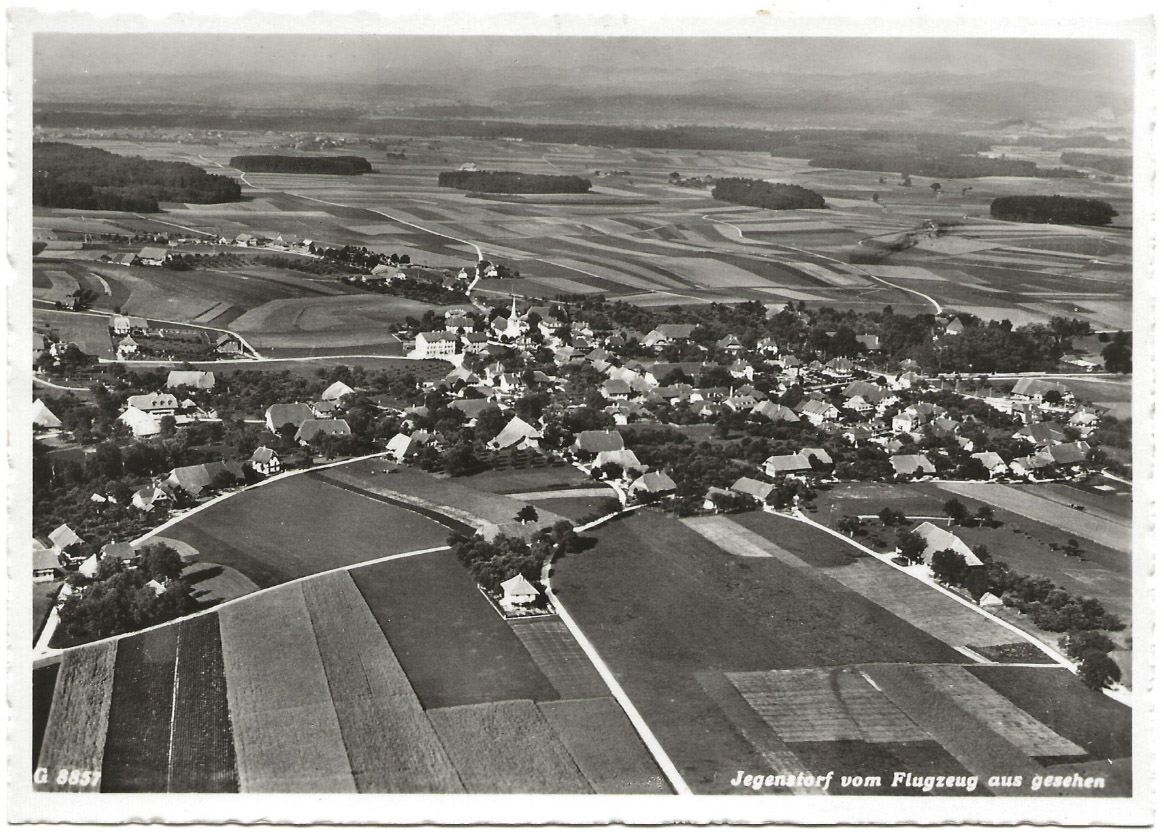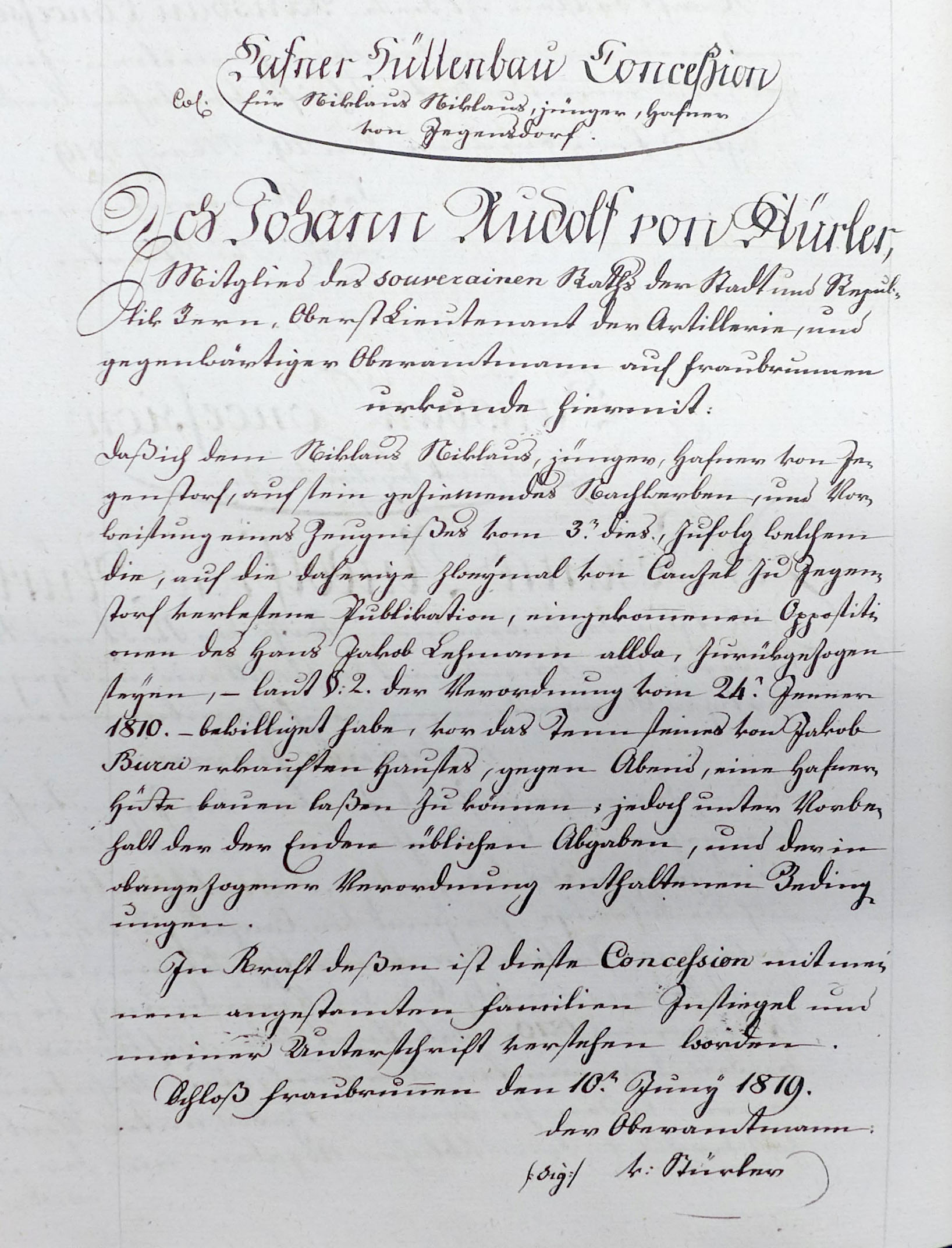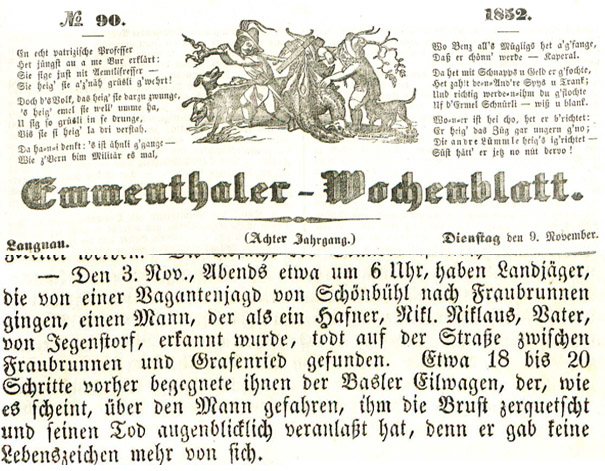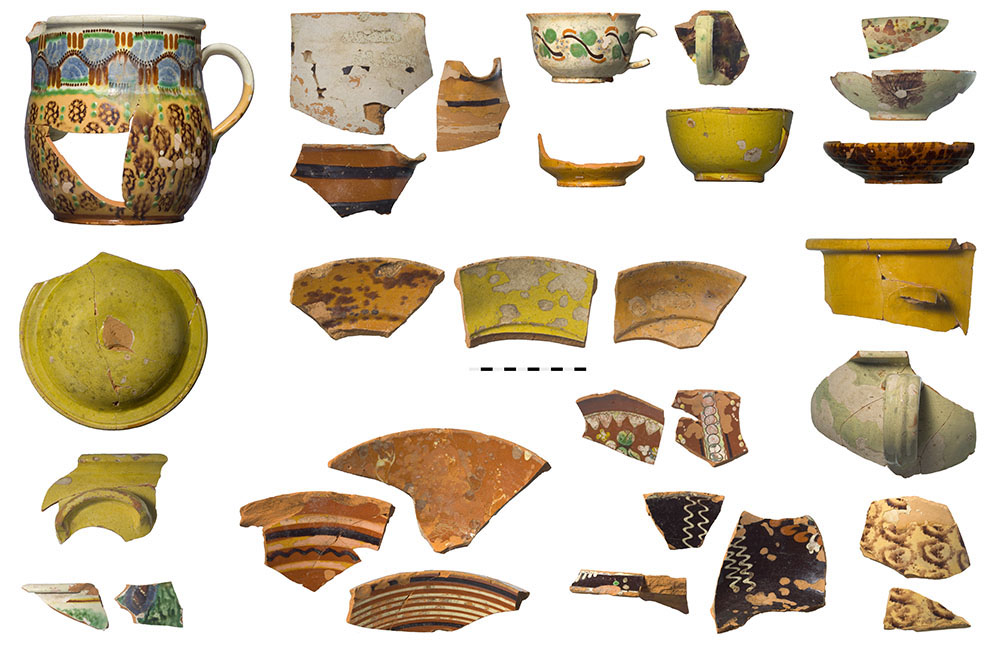
Jegenstorf as seen from the air, 1939, view towards the north-east.
Andreas Heege, Andreas Kistler, Alfred Spycher, 2025
Niklaus_Jegenstorf_genealogical data
The first Niklaus potters appear to have become involved in pottery making in Jegenstorf from the late 18th century onwards, though at least two other potters were already active locally: Abraham Reutlinger (1673-1741) and Rudolf Los[s]er, (biographical dates unknown, records of business activities from 1749-1750, Boschetti-Maradi 2006, 210).
To our knowledge, Bendicht Niklaus (1738-1804) was the first member of the Niklaus family to learn the craft. We do not know what his father did for a living. Bendicht married twice (on 9th January 1763 and on 20th December 1778). The first marriage produced seven children, the second just one (family tree).
1 and 5 Altgasse in Jegenstorf, location of the potter’s workshop
1 and 5 Altgasse in Jegenstorf, change of hands GBJ
Throughout the course of his life, Bendicht Niklaus (1738-1804) acquired various properties and fields in Jegenstorf which, after his death, were divided between his widow and the surviving children from his first marriage (GBJ_01_116-122; GBJ = Jegenstorf cadastral register):
“1. Residential premises with adjacent potter’s workshop and farmstead, approximately 2 Maad (a unit of measurement approx. 0.8 acres), along with the use of a small farm common. 2. The Bachtelen field in the Oberfeld area of Jegenstorf, c. 2 Jucharten (1 Jucharte = 1-1.5 acres). 3. The Bohlwinkel field, c. 2 Jucharten. One half of this house and land is bequeathed to Bendicht [Bendicht Niklaus, 1774-1839]. The other half, including the potter’s workshop, is bequeathed to Niklaus [Niklaus Niklaus, 1764-1823]. Proviso: Bendicht has the right to use the potter’s workshop. 4. Another property in the village, including a bakehouse and granary as well as a garden. On this property, a tax of one Meudt of spelt (Mütt = an old unit of weight specifically for grain) must be paid to the hospital in Bern every year. The property also includes the use of a small farm common. 5. A piece of land in the Eschpli area c. 3/4 Jucharte. 6. In the Ischenmat c. 1/2 of a Maad. 7. The Neuholz field c. 3/4 Jucharte. 8. The Münchring field c. 3/4 Jucharte 9. The Krautmatt field c. 3/4 Jucharte. Nos. 4 to 9 are bequeathed to the youngest son, Jakob [1777-1832].”
Based on later changes of hands, the potter’s workshop and the residential premises can be identified as present-day nos. 1 and 5 Altgasse lane. Both plots have since been redeveloped.
The Bernese annual accounts mainly for Fraubrunnen record “stove works” by Bendicht Niklaus (1738-1804) for the period between 1780 and 1797. The records for 1780 show that this also included the installation of new tiled stoves (Utzenstorf, County Clerk’s Office and Kirchberg, Prebend House), which cost 46 or 32 Kronen respectively. From 1786 to 1797, his work consisted of stove repairs in Fraubrunnen. The citizens’ register of 1798 lists Bendicht as well as his oldest son, Niklaus (1764-1823), as potters. His younger son, Bendicht (1774-1839), was not yet married and is therefore unlikely to have had his own workshop at that time. When Bendicht Niklaus senior sold half a Jucharte of arable land in the Niederfeld area of Jegenstorf to his son Niklaus in 1803, he probably did so from his sickbed at the Inselspital Hospital in Bern (StAB Bez Fraubrunnen A, 216, 316-318). He died in 1804.
The next generation had the two potters, Niklaus Niklaus (1764-1823) and Bendicht Niklaus (1774-1839) as well as the youngest son, Jakob (1777-1832), who in 1808 was recorded as a “Kachelkrämer” or pottery salesman (KRJ_07_51), and obviously traded in or peddled crockery. The settlement of the estate in 1805 (see above, GBJ 01, 116-122) resulted in the two brothers, Niklaus and Bendicht, sharing the residence and the potter’s workshop at 1 and 5 Altgasse lane.
On 28th September 1787, Niklaus married Barbara Müller (1766-1825) in Oberburg. The couple had three children (see the family tree). Bendicht junior married Elisabeth Kunz (1778-1839) on 23rd January 1801 in Oberburg. They had five children, none of whom became involved in pottery making. In 1802, Bendicht purchased “approximately three quarters of a Jucharte of arable land, the Niederfeld field in the Niederfeld area” of Jegenstorf for 156 Kronen with his father acting as guarantor (StAB Bez Burgdorf B 682, 58-59). We know nothing else about Bendicht, except for the fact that in December 1838, he sold his half of the house and the other assets, including the use of the potter’s workshop, to his son Bendicht Niklaus (1806-?) (GBJ_09_198-203). Bendicht Niklaus junior was a wood turner. When Bendicht Niklaus senior (1774-1839) died, pottery making at 1 and 5 Altgasse lane ceased, although the cadastral register continued to list it as a “residential building, formerly a potter’s workshop” until 1893 (GBJ 48, 294-308).
The lives of Bendicht’s brother, Niklaus Niklaus (1764-1823) and his family appear to have run less smoothly. In 1818, Niklaus was accused of stealing wood (contrary to forest law) from the forest common by forest warden Jakob Aeberhart and had to pay a fine (StAB Bez Fraubr B 366_8_1818). In 1821, he was charged with abusive language and libel against Aeberhart and was forced to make an apology (StAB Bez Fraubr B 367, 153).
The deaths of Niklaus Niklaus in 1823 and his wife Barbara Müller in 1825 led to a further settlement of the estate and in April 1825, the property at 1 and 5 Altgasse lane was divided among the heirs. The farmhand Johannes Niklaus (1791-1847, see the family tree) was given half of the property, while the potter Niklaus Niklaus (1788-1852) got four fields (GBJ_04_235-239). This made sense because on 30th January 1819, Niklaus Niklaus (1788-1852) had already purchased his own homestead: “a house with adjacent farmstead and garden comprising approximately two Maad. This also includes half a bakehouse and half a granary, as well as the use of a house common. Purchase price: 2,100 Kronen or 7,000 Bernese pounds” (GBJ_03_87-89). This was the property at present-day 12 General-Guisanstrasse (Jegenstorf 12 Guisanstrasse information from GBJ).

On 10th June 1819, Johann Rudolf von Stürler, the district magistrate of Fraubrunnen, granted permission for him to “build a potter’s workshop in front of the threshing floor of the western side of the house he purchased from Jakob Buri” (StAB Urbarien Fraubrunnen 21, 490).
On 7th April 1809, Niklaus Niklaus had married Elisabeth Kunz (1786-1832) from Lyssach in Jegenstorf. The couple had six children, of whom the eldest son, Niklaus Niklaus (1810-1879), also became a potter (see the family tree).
Beim Jegenstorfer Dorfbrand vom 24. April 1820 wurde das Anwesen mit der Töpferei ein Raub der Flammen (Materialien zum Dorfbrand im StAB, Signatur: OG Jegenstorf 5, ausserdem: Chronik Amt Fraubrunnen 3, 1958, 27-33).
In 1826, Niklaus Niklaus sought a loan of 1800 Bern Kronen and offered the following as security: “1. A newly built house with a tiled roof and a barn, fire-insured at no. 129 for 2,200 francs and an adjacent new residential building with a potter’s workshop at no. 130 for 600 francs, incl. farmstead and garden c. 2¾ Jucharten. 2.-6. Land and the use of a small farm common” (GBJ 04, 325-328).
In February 1835, Niklaus Niklaus (1788-1852), having become a widower in 1832, sold the property to his son Niklaus Niklaus junior (1820-1879) (GBJ 07, 450-458). The reasons for this sale are not clear. We can assume that the father and his son, who at that time was still single, both worked there together.
In 1836, the son succeeded in bringing his father to court for unlawfully offering a field as security for a loan (StAB Bez Fraubr B 371, 92).
In May 1838, Niklaus Niklaus senior was fined for verbally abusing government agent Zulauf in Grafenried (StAB Bez Fraubr B 372, 128). Two years later, in May 1840, he was charged by gendarmes Schüppach and Feller with verbally abusing one Samuel Bischoff.
On 30th November 1838, Niklaus Niklaus senior married the widow Anna Barbara Ryser, née Eggimann (1779-1855, from Dürrenroth). However, the marriage does not appear to have been a very happy one, as we can see from a court ruling in September 1843. The Jegenstorf Guardianship Authority had apparently stripped him of the right to manage his own financial affairs not long after 1838, which meant that he was no longer in a position to “support” his wife. Because she insisted on the repayment of her dowry, which Niklaus either did not want to or was not able to comply with, he was imprisoned in Fraubrunnen for six weeks before being compelled to “Swear a formal oath to refrain from entering the territory of the Republic of Bern until such time as the claimant is fully reimbursed the sum in question and all costs.” (StAB Bez Fraubr B 375, 96). It seems that Anna Barbara Eggimann received the money she was due, although Niklaus Niklaus, who at that time was still identified as a “potter from and in Jegenstorf”, was forced to declare bankruptcy on 18th March 1844 (StAB Bez Fraubr B 375, 190).

In 1852, we then hear of the potter’s death in tragic circumstances. On 3rd November he was run over by the stagecoach, the Basel dormeuse chariot, which does not appear to have even stopped after the incident but continued on its journey (was the potter lying in the road drunk and sleeping off his hangover?). The case was passed on to the Department of Justice and Police in Bern, but no further information is given (Emmenthaler Bote newspaper, Issue 91, 11th November 1852).
The son, Niklaus Niklaus (1810-1879), also a potter, married Anna Witschi (1819-1866, from Jegenstorf) on 3rd May 1839. The couple had four children (see the family tree). His son, who was also named Niklaus Niklaus (1843-1902), did not become a potter. Niklaus Niklaus (1810-1879) also seems to have led a rather turbulent life as, in June 1845, he too was charged with verbally abusing someone (StAB Bez Fraubrunnen B 376, 47). Furthermore, the “sitting of the Frevelgericht [a special court to settle petty conflicts] on 1st August 1855”, imposed a fine of 30 francs on Niklaus Niklaus and his wife, Anna Witschi, and ordered a daily allowance of 5 francs to be paid to the forest warden; their cart and tools were to be confiscated until the fine was paid in full. Apparently, they had been caught committing a fairly substantial theft of wood (StAB Bez Fraubrunnen B 378, Bd. 20, 333).
Before that, on 20th January 1853, Niklaus Niklaus had sold the property including the adjacent residential building and potter’s workshop to Johann Ulrich Mägli from Oberbipp, notary public and legal agent in Jegenstorf (GBJ 17, 52-57), possibly because he could no longer afford the interest payments on the property (12 General-Guisanstrasse). We can probably assume that he continued to rent the property and produce pottery there. On 4th October 1867, Niklaus Niklaus, who had been widowed in 1866, was finally forced to declare bankruptcy (for information on the liquidation process see: Tagblatt der Stadt Biel, Volume 5, Issue 235, 4th October 1867). He died in 1879.
We can assume that the Jegenstorf potter Johann Jakob Häberli (1858-1908) rented the property of Niklaus Niklaus (1810-1879) at 12 General Guisanstrasse in Jegenstorf or at least the residential building and potter’s workshop following Niklaus’s bankruptcy and death. On 13th October 1903, Johann Jakob purchased the entire property (GBJ_55_384-388).
Unfortunately, there are no ceramics bearing the marks or signatures of the Jegenstorf Häberli potters and we do not know what their products looked like. However, 19th century finds from archaeological excavations carried out in recent years have painted an impressive picture of the kitchen- and tableware of Jegenstorf farming families at the time.

Jegenstorf, Kirchgasse, refuse pit 561, archaeological finds of everyday pottery dating from the period prior to c. 1890: milk jugs, cups, saucers, tureens, plates, dishes and chamber pots. Photos by Badri Redha, Archäologischer Dienst des Kantons Bern.
Surely, some of the pieces must have been made by the Häberli and Niklaus potters in Jegenstorf.
Translation Sandy Haemmerle
References:
Boschetti-Maradi 2006
Adriano Boschetti-Maradi, Gefässkeramik und Hafnerei in der Frühen Neuzeit im Kanton Bern (Schriften des Bernischen Historischen Museums 8), Bern 2006.

